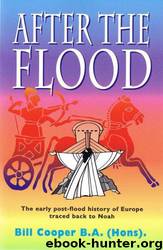After the Flood: The Early Post-Flood History of Europe by Bill Cooper

Author:Bill Cooper
Language: eng
Format: mobi, epub
Tags: Europe, Bible and Evolution, Knowledge, God, Creation, Theory Of
ISBN: 9781874367406
Publisher: New Wine Press
Published: 1995-09-15T05:00:00+00:00
informants at the Natural History Museum in Kensington, could tell this since the creature was no longer available for examination, we can only guess at, especially considering that the marine biologist on board the vessel, the Zuiyo-maru, had sketched the creatures skeletal structure and it is nothing like that of a shark (see Figure 10.1).
Marine biologists are highly trained scientists whose ability to detect disease and mutations in fish and marine mammals is crucial to the health of the consumer let alone the profits of the fishing vessel concerned, so their knowledge of marine life is necessarily very great. Yet the BBC would have us believe that Michihiko Yano, the government-trained and highly qualified marine biologist who examined, photographed and measured the monster, wouldn't know a dead shark when he saw one!
But western officialdom has not always been as averse as this at acknowledging and even mentioning in official reports the existence of creatures which are supposed by today's establishment to have died out millions of years ago. The following, for example, was penned only two hundred years ago in 1793 and describes creatures that sound suspiciously like pterodactyls or similar. Remember, it is an official and very sober government report that we are reading:
'In the end of November and beginning of December last, many of the country people observed dragons appearing in the north and flying rapidly towards the east; from which they concluded, and their conjectures were right, that...boisterous weather would follow.'
This report is intriguing for the fact that exactly one thousand years before an almost identical report made its appearance in the Anglo-Saxon Chronicle under the year 793.
The two accounts are nothing more than country people being able to predict the weather by observing the behaviour of the animals, which is a skill that they have always possessed and used, and these accounts, combined with later records of the years 1170, 1177, 1221 and 1222, of 1233 and of 1532, suggest that these creatures could tell the approach of bad weather coming in off the Atlantic and simply migrated to calmer 81
regions while the bad weather lasted. Considering the flimsiness and fragility of the wings of pterodactyls and similar creatures, the reports make eminent sense.
But now we come to the most notable records of all. They are written works that are remarkable for the graphic detail with which they portray the giant reptiles that the early Saxons, Danes and others encountered in Northern Europe and Scandinavia. In various Nordic sagas the slaying of dragons is depicted in some detail, and this helps us to reconstruct the physical appearance of some of these creatures. In the Volsungassaga, for example, the slaying of the monster Fafnir was accomplished by Sigurd digging a pit and waiting, inside the pit, for the monster to crawl overhead on its way to the water. This allowed Sigurd to attack the animal's soft under-belly. Clearly, Fafnir walked on all fours with his belly close to the ground.
Likewise, the Voluspa tells us of a certain
Download
After the Flood: The Early Post-Flood History of Europe by Bill Cooper.epub
This site does not store any files on its server. We only index and link to content provided by other sites. Please contact the content providers to delete copyright contents if any and email us, we'll remove relevant links or contents immediately.
The Five People You Meet in Heaven by Mitch Albom(3440)
Real Sex by Lauren F. Winner(2939)
Name Book, The: Over 10,000 Names--Their Meanings, Origins, and Spiritual Significance by Astoria Dorothy(2915)
The Secret Power of Speaking God's Word by Joyce Meyer(2878)
The Holy Spirit by Billy Graham(2840)
0041152001443424520 .pdf by Unknown(2734)
ESV Study Bible by Crossway(2713)
How The Mind Works by Steven Pinker(2701)
Ancient Worlds by Michael Scott(2584)
The Meaning of the Library by unknow(2476)
Churchill by Paul Johnson(2476)
The ESV Study Bible by Crossway Bibles(2459)
The Gnostic Gospels by Pagels Elaine(2445)
MOSES THE EGYPTIAN by Jan Assmann(2350)
Jesus by Paul Johnson(2278)
City of Stairs by Robert Jackson Bennett(2263)
The Complete Dead Sea Scrolls in English (7th Edition) (Penguin Classics) by Geza Vermes(2207)
Ancient Near Eastern Thought and the Old Testament by John H. Walton(2172)
The Nativity by Geza Vermes(2153)
